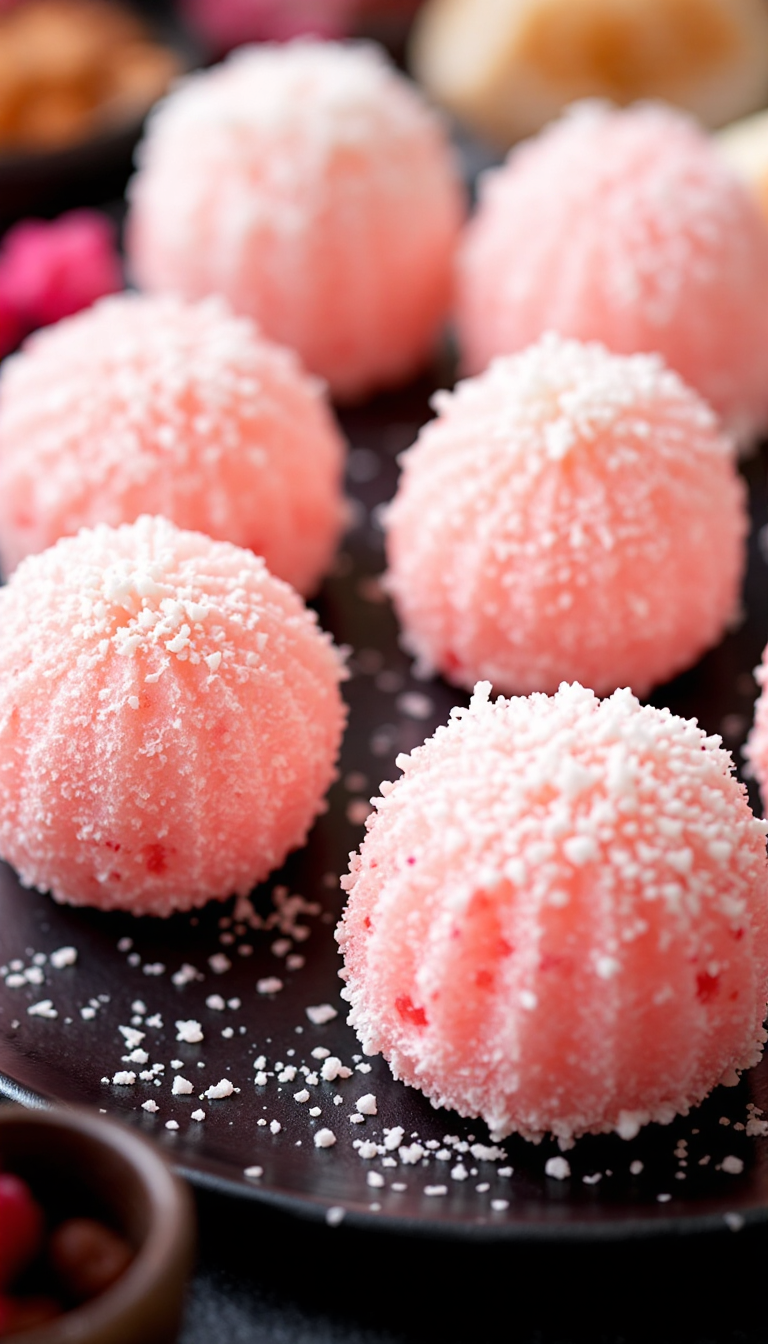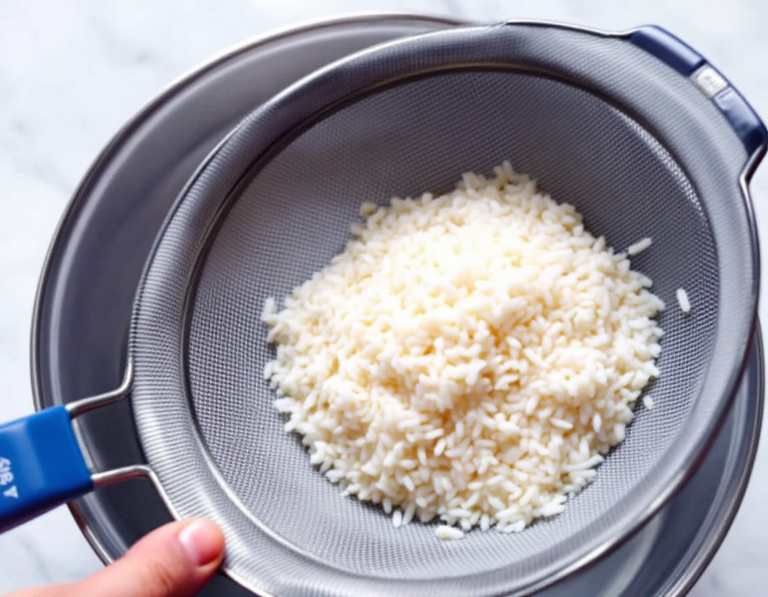
Have you ever stumbled upon a dish that just transports you to a different place—like a burst of cherry blossoms in spring? That’s the magic of sakura mochi for me.
It’s like holding a piece of Japan right in your hands, delicate and sweet, with a hint of nostalgia. I remember the first time I tried it—on a trip to Tokyo during cherry blossom season (oh, the colors!
)—and it was love at first bite. This vegan version brings all that beauty without the fuss, and honestly, who doesn’t need a bit of edible poetry in their life?
Let’s roll up our sleeves and get a taste of those cherry blossoms, shall we?
Steps
- Rinse the glutinous rice in a large bowl by adding water, discarding it immediately, and repeating until the water is nearly clear. Drain the rice thoroughly using a fine-mesh sieve.
- Prepare a small amount of red water by mixing a tiny bit of red food coloring with 2 teaspoons of water. Gradually add this red water to the rice water to achieve a soft pastel pink color.
- Cook the well-drained rice in a rice cooker with ¾ cup of room-temperature water and 1 tablespoon of sugar, ensuring the rice is evenly submerged. Use the regular setting, which includes soaking and steaming times.
- While the rice cooks, make a syrup by dissolving 1 tablespoon of sugar in 4 tablespoons of water. Roll sweet red bean paste into 15-gram balls using wet hands to prevent sticking.
- Desalt salt-pickled cherry blossom leaves and flowers by soaking them in water for 20-30 minutes to remove excess salt.
- Once cooked, partially mash the rice with a wooden pestle, then divide it into 8 equal portions. Shape each portion into a cylinder using syrup-moistened hands.
- Flatten each rice portion on plastic wrap, shape it into an oval, and place a red bean paste ball in the center. Wrap the rice around the filling and smooth the surface with the plastic wrap.
- Wrap the mochi with desalted cherry blossom leaves, ensuring the back of the leaf faces outward. Optionally, place a cherry blossom on top for decoration.
- Serve immediately, or allow the mochi to sit at room temperature for an hour to absorb the leaf’s flavor. Store leftovers in an airtight container at room temperature, or freeze for longer storage.

Ingredients
- Japanese short-grain glutinous rice (mochigome), 1 rice cooker cup (¾ US cup)
- Sugar, 1 Tbsp
- Red food coloring (powder or gel)
- Sweet red bean paste (anko), smooth kind (koshian), 4¼ oz
- Salt-pickled cherry blossom leaves, 8 leaves
- Salt-pickled cherry blossoms (optional), 8 blossoms
- Water, ¾ cup for cooking rice
- Water, 2 tsp for red water
- Sugar, 1 Tbsp for syrup
- Water, 4 Tbsp for syrup
- style Sakura Mochi.
Nutritional Values
Calories: 952 kcal | Carbohydrates: 216 g | Protein: 16 g | Fat: 8 g | Saturated Fat: 8 g | Polyunsaturated Fat: 0.32 g | Monounsaturated Fat: 0.32 g | Sodium: 144 mg | Potassium: 760 mg | Fiber: 8 g | Sugar: 64 g | Vitamin A: 632 IU | Vitamin C: 8 mg | Calcium: 56 mg | Iron: 8 mg
FAQ
- What is Sakura Mochi and when is it typically enjoyed?
- Sakura Mochi is a Japanese confectionery featuring a light pink glutinous rice ball filled with sweet red bean paste, wrapped in an edible pickled cherry blossom leaf. It is traditionally enjoyed during the spring season in Japan, especially for Girls’ Day and cherry blossom viewing.
- What are the different styles of Sakura Mochi?
- There are two main styles of Sakura Mochi in Japan: Kanto-style, made with a type of glutinous rice flour called shiratamako, and Kansai-style, which uses domyojiko, a coarsely ground glutinous rice. The Kansai version is more common outside Japan, often made with mochigome, a short-grain glutinous rice.
- What are salt-pickled cherry blossom leaves and where can they be found?
- Salt-pickled cherry blossom leaves are tender young leaves preserved with salt, contributing a mild sweetness and cherry blossom aroma to Sakura Mochi. They can be challenging to find outside of well-stocked Japanese grocery stores but are available for purchase online.
- What are some tips for making perfect Sakura Mochi?
- To achieve the desired pastel pink color, gradually add red food coloring to the rice water. Wetting your hands with a sugar-water syrup called temizu helps in shaping the rice and red bean paste. For presentation, ensure the more veined side of the cherry blossom leaf is facing outwards when wrapping the mochi.
- How should Sakura Mochi be stored, and what is the best way to serve it?
- It’s best to consume Sakura Mochi on the same day it’s made, as rice hardens when refrigerated. To store longer, freeze it for up to a month and defrost it before serving. Pair it with Japanese drinks like matcha or cold brew green tea for an authentic experience.
Tips
- Gradually add red food coloring to the water when preparing the rice to achieve a soft, pastel pink hue. Prepare a small amount of colored water separately and add it incrementally to avoid over-saturating the rice.
- Use a sugar-water solution, known as temizu, to moisten your hands when shaping the mochi and bean paste. This syrup prevents sticking and helps maintain food safety.
- Accurately measure both the rice and red bean paste to ensure the mochi is well-shaped and has a balanced flavor. Aim for an oval shape approximately 4? inches in length and 2¾ inches in width.
- When wrapping the mochi with cherry blossom leaves, place the side with visible veins facing outward. This enhances the presentation by showcasing the leaf’s natural patterns.
Equipment
- Rice Cooker – A reliable rice cooker with settings for cooking glutinous rice.
- Kitchen Scale – For accurately measuring ingredients like red bean paste and rice portions.
- Surikogi (Japanese Wooden Pestle) – Used for pounding the glutinous rice.
- Fine-Mesh Sieve – To effectively drain and rinse the rice.
- Plastic Wrap – For shaping and wrapping the mochi, although this may be more common, you might need a specific type or large quantity.
- OXO Small Cookie Scoop – Handy for measuring and shaping red bean paste balls.
- Flat Whisk – Useful for making the syrup by ensuring sugar dissolves completely.
- Pickled Cherry Blossom Leaves and Blossoms – These are specific to Japanese cooking and may need to be sourced online if not available locally.